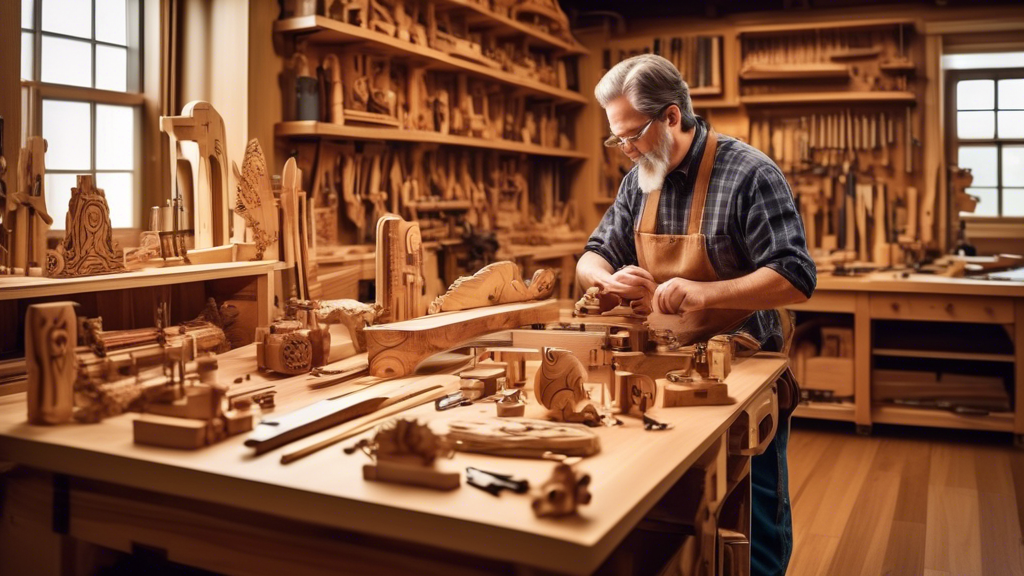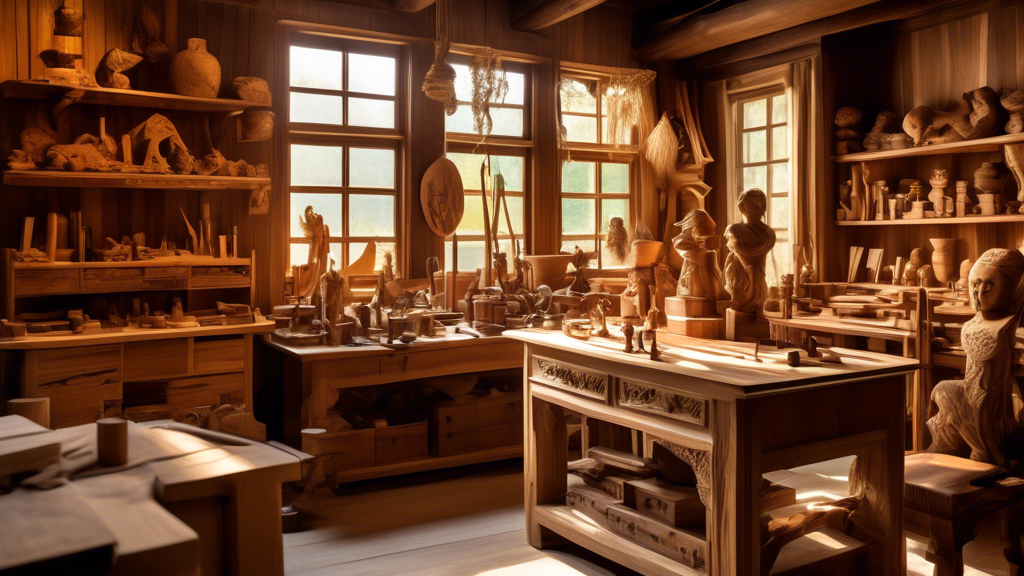Exploring the Beauty and Craftsmanship of Woods Works
woodworking enthusiasts, gather ’round! Today we’re diving into the world of woods works, a celebrated form of artistry that beautifully marries aesthetic appeal with skilled craftsmanship. Whether you’re a seasoned craftsman familiar with the delicate dance of chisel and grain or a beginner just getting acquainted with the allure of freshly cut timber, woodworking is a versatile and enduring craft that has the power to captivate individuals across cultures and generations.
At its core, woods works is more than just constructing furniture or cabinetry; it’s about capturing the sophistication and natural elegance of wood. This makes woods works not only a staple in traditional design but also a continuous source of inspiration in modern architecture and interior design. Wood has a language, a story it tells through its textures and shades, transforming any ordinary space into one that resonates warmth and intrigue.
But let’s address the curious minds itching to get their hands dusty. There’s a vibrant spectrum of techniques in woods works to explore—from the precise art of carving and turning, where the wood shaves away like chocolate curls, leaving behind masterpieces, to the intricate puzzle-solving process of joinery that challenges even the most logical of thinkers. Oh, and let’s not forget the symphony of tapping, sawing, and sandpapering that accompanies every project—a tune all wood lovers hum along to.
Of course, no conversation about woods works would be complete without mentioning the magnificent diversity of materials involved. Whether you fancy the robust reliability of hardwoods like oak and walnut or the softer touch of pine and cedar, each type brings its own unique flair to your artistic palette. Think of it like choosing between jazz and classical music—both beautiful in their own right, yet each providing a distinct atmosphere and ambiance to your creations.
So join us on this journey as we peel back the layers of woods works, sharing tips, tales, and even our own little blunders because, let’s face it, who hasn’t mistaken their thumb for the wood? It’s all part of learning, laughing, and growing together in this warm, supportive community of woodworkers. Welcome to your next woodworking adventure!
Introduction to Woods Works: The Art and Essence of Craftsmanship
Welcome to the enchanting world of woods works, where creativity meets precision and Mother Nature provides the canvas. Whether you’re a bright-eyed beginner looking to carve your first masterpiece or a seasoned pro who’s practically part tree at this point, there’s something about wood that captures our heartwood and soul. What makes woods works more than just a craft? It’s the perfect blend of artistic flair and craftsmanship—a dance between nature’s raw beauty and the artisan’s skilled touch.
Across the globe and throughout history, woods works has been an integral part of cultural artistry. Just think of the ancient Japanese temples, brimming with zen-like precision, or the ornate European cathedrals with their intricate carvings. Today, woods works continues to weave its magic into modern design and architecture, all while retaining its timeless charm. In fact, when you have a hand-sculpted wooden piece at home, it’s like owning a slice of history—plus, anyone who visits will definitely think you’ve got some seriously sophisticated taste.。
If you’ve ever marveled at a stunning piece of woodwork and wondered, How did they do that without losing a finger? then you’re in good company. Don’t fret; whether you’re working with the simplest hand saw or the fanciest laser cutter that makes you feel like you’re in an episode of Star Trek, there’s a place for you in the woods works community. Remember, it’s about enjoying the journey as you create—splinters, sawdust, and all.
In the following sections, we’ll delve deeper into the techniques that set the wood chippers apart from the woodwhisperers. From the thrill of carving (yes, thrill!) to the nuances of wood selection, there’s a whole world of discovery waiting as you explore the essence of woods works.
Click Here For The World’s Largest Collection of 16,000 Woodworking Plans

Unveiling the Beauty and Diversity of Woods Works Techniques
Alright, folks, let’s dive into the heart of woods works – the techniques that transform raw timber into stunning pieces of art and functional masterpieces. Whether you’re just getting your toes wet or you’re a seasoned pro wading knee-deep in sawdust, understanding these techniques is crucial. After all, every woodworker knows that the magic really happens at the meeting point of skill and creativity.
Carving: The Chisel Jedi’s Craft
Carving is where you get to unleash your inner Michelangelo, albeit with a block of wood rather than marble and probably fewer togas in your vicinity. This technique in woods works involves shaping the wood by removing pieces with tools such as chisels, gouges, or even a trusty whittling knife for those really intimate sessions.
Imagine taking a plain ol’ block of basswood and channeling your energy into creating ornate patterns or realistic figures. It’s about as rewarding as digging out the most stubborn of splinters! Don’t worry if you start off with a squirrel that looks more like a potato — practice makes perfect. Just remember, every masterpiece began as a series of cuts that looked awkward at first.
Turning: The Art of Round and Round We Go
If carving is your sculptor friend, woodturning is the potter’s wheel of woods works. This wonderful contraption lets you spin a chunk of wood at high speeds, allowing you to shape it with tools to your heart’s content. The majestic lathe isn’t just a noisy compliment to your workshop’s ambiance; it’s your gateway to creating everything from charming candleholders to bowls that make mere mortal salad bowls weep in shame.
As with all things spinny, patience and steadiness are key. Take it slow and steady at first — there’s nothing like the rustic appeal of a handcrafted baseball bat to get you hooked! When things don’t go as planned (trust me, I once made a rolling pin best described as a crooked wizard’s wand), remember: all lopsided turns teach more than perfect ones ever could.
Joinery: Where Pieces of a Puzzle Come Together
The backbone of woods works is joinery, the magical way that pieces of wood come together without shouting “Hey, glue!” Lay back and marvel at how dovetails or mortise and tenon joints transform lumber into heirloom-worthy structures. This technique isn’t just about putting together shelves that won’t collapse under the weight of your Stephen King collection; it’s about crafting connections that could withstand the test of time and a Viking raid.
Tackle the basics, like butt and miter joints, first. As you feel more daring and less inclined to bite into your creations’ rough edges, venture into the world of box and dovetail joints. Whatever you do, don’t fret over the mathematics of it all — as I found out when one of my bookcase’s joints was so tight it wouldn’t budge (I had to use the age-old technique of gently persuading it with a rubber mallet), getting the right fit comes with practice and sometimes even light perspiration.
The Diversity of Materials: A Tale of Hardwoods and Softwoods
Ah, the eternal debate for any practitioner of woods works: hardwoods vs. softwoods. Which type will win your heart (and hold up your new table)? Let’s get this straight: it’s not about which is better, but which suits your project like the perfect-sized dovetail.
Hardwoods, like oak or walnut, are the densified superheroes of wood. They’re ideal for durable furniture and artworks meant to bear the brunt of daily admiration (and occasional sit-on tests). Picture a whisky-brown oak dining table — strong enough to survive family Thanksgiving and still look dapper.
Softwoods, like pine and cedar, offer easy manipulation and a fresh, lively presence. When crafting pieces where weight isn’t a limitation, or you want to channel the cosiness of a log cabin, softwoods should be your go-to chronicle of choice!
Whichever you lean toward, remember: the beauty of woods works lies in free expression and experimentation. Whether you’re making a simple birdhouse (where I guarantee you’ll get acquainted with splinters) or an elaborate wardrobe fit for Narnia, embrace your journey. In the realm of woods works, there’s no wrong way to plane a board — just your’ve-novel-and-ever-evolving one.
As we wrap up our exploration into the enchanting world of woods works, it’s clear that this art form is much more than a simple craft—it’s a fascinating tapestry woven with threads of history, tradition, and exquisite skill. Whether you’re a seasoned artisan or just getting sawdust in your veins, the beauty and complexity of woods works offer endless opportunities for creativity and expression.
Through techniques like precise carving or mesmerizing turning, each method in woods works contributes uniquely to transforming simple pieces of wood into awe-inspiring works of art. The materials, ranging from robust hardwoods to versatile softwoods, not only influence the final appearance but also shape the very soul of the creation. As any craftsperson can tell you, wood has a personality—you learn to listen to its whispers as the grain guides your chisels and saws.
And lest you think that woods works is reserved for the elite few, remember that innovation often starts with curiosity and simple tools. Sure, having a state-of-the-art workshop with all the bells and whistles can be heavenly, but some of the most remarkable pieces emerge from modest beginnings. It doesn’t matter if you’re armed with a high-tech lathe or your great-granddad’s trusty hand plane; what truly counts is the passion you bring to your craft.
But let’s be real for a second—things won’t always go according to your perfect plan. There are days when your beloved project seems determined to turn into an unintentionally abstract piece (fancy name for a snafu, right?). Trust me, I’ve been there, staring at what was supposed to be a regal chair, now resembling a very confused birdhouse. Yet these moments, though frustrating, are fertile grounds for growth and creativity. They teach us resilience and sometimes how to innovate by necessity, giving a whole new meaning to the phrase make it work.
In the end, woods works invite us all—novices and masters alike—into a community bonded by a shared appreciation for the beauty of wood and the craftsmanship it demands. So, let us embrace the art of woods works, continue to inspire and support each other, and keep discovering new possibilities in this timeless craft. Whether you’re ready to dive into a new technique, experiment with an unfamiliar material, or just need some camaraderie to keep you company in the workshop, remember that the world of woods works is full of discovery, delight, and yes—a little bit of dust. Keep those chisels sharp, your spirits high, and who knows? You might just carve out your own niche in this wonderful world of craftsmanship.
Click Here For The World’s Largest Collection of 16,000 Woodworking Plans

